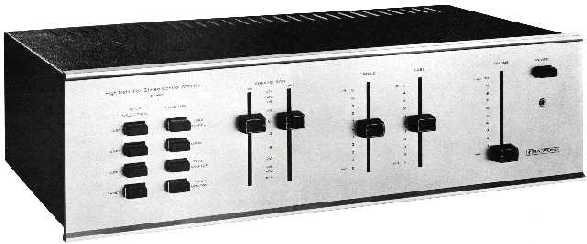
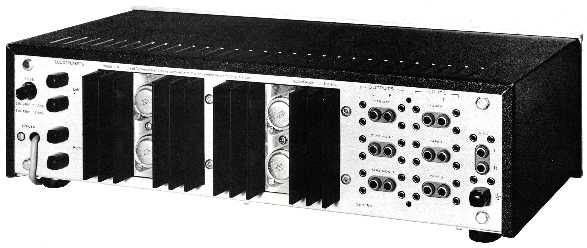
Radford HD250 and ZD22Following a well-run course, Radford's HD250 and ZD22 used the same preamps, the former containing two power amps and a correspondingly more powerful supply, a regulator then feeding two AC-coupled output stages. More or less identical in outward appearance, these models represented a high-quality build for the time.
Push-button input selector and function switches preceded the single-gang slider input level and channel balance controls. Some means of accommodating varying input levels was useful in matching equipment, as seen in the following year's, but more flexible, Cambridge P60. Defeatable tone controls then fed the volume control (all double-ganged). The use of sliders determined the case's height but were considered fashionable, the 'dB' scale on the input selector pots being deemed 'technical' and thus desirable to some.
A service manual (PDF) is available and in response to a call for original specs, Axel Dahl has kindly supplied some of these.


Although a modular approach aided servicing, short-comings were noted in both models that could have been avoided at the design stage. Exposed TO3 cans, for example, are always a bad idea. Screens were provided in the transformers and both cases to shield the supplies, but the main smoothers had been wired via single runs. Separate runs from the bridge rectifier and regulator could have reduced ripple. The 30V regulator operating differentials seemed a little high (indicative of a high secondary winding impedance?), the HD250's TO3 series pass device (2N4348; 800kHz, 140V, 10A, 120W, hFE 15/60) could have been replaced with the same type as the NPN output transistors. The ZD22's TO5 40349V1 (160V, 1.5A cont, 4W4) sported it's own 40°C/W heat-sink. Current-limiting, however, was included which, unfortunately, could introduce distortion on peaks.
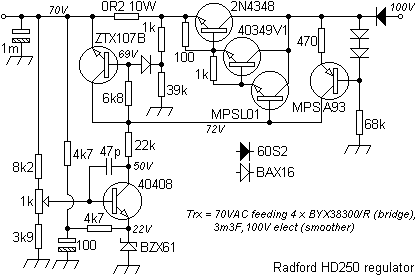
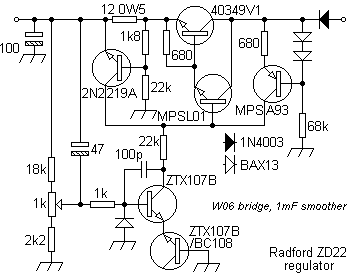
The HD250's power amplifiers employed a hefty output pair (no information available, MJ15003/4 equivalents suggested - 2MHz, 140V, 20A, 250W, hFE 25-150) and current limiting that could, again, introduce transient distortion.

The symmetrical layout of the output and driver stages differed markedly from that of the input. Interestingly, no thermal tracking of the quiescent current was possible, the power amp being split between two wired PCBs, a privately held cause of some of the amplifier's instabilities, as could some board connectors. Similarly, both leads to the speakers from both channel's output electrolytics (C64s) were twisted tightly together over much of their length, a feature repeated in the preamp.
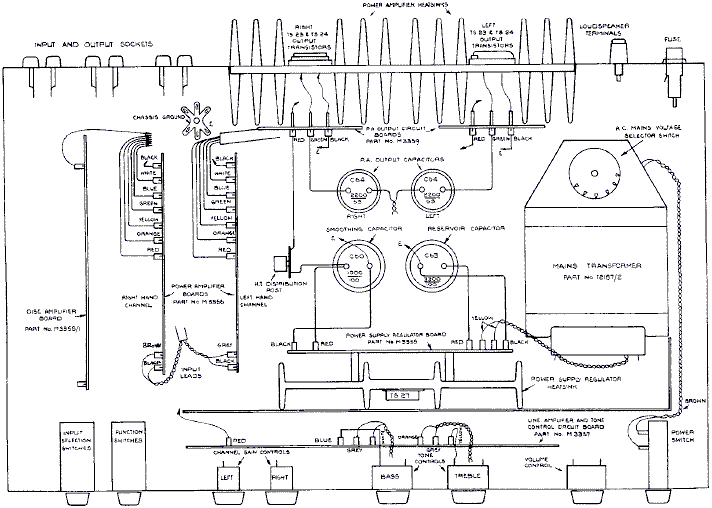
Ideally, the PA PCBs should have been adjacent to the heat-sinks. However, the space taken up by the input and low level output sockets effectively prevented this. Japanese suppliers and manufacturers were already utilising compact phono socket clusters. How British manufacturers avoided this concept bewilders this author, as does the lack of provision of a break-out between the volume control and PAs or the absence of DIN connectors which still had a few years to run. The inclusion of these, and TO3 insulating covers which cost pence, would have lifted this design. The internal wiring defficiencies are equally baffling.To reduce noise the RIAA input was wired directly to it's preamp, only the output being switched. At the same time, attention had been given to the accuracy and quality of the RIAA feedback stage, again adding marketable appeal, using standard values.
With an input derived from the recommended reciprocal filter (shown below) test responses were expected to be within ±0.5dB from 50Hz to 20kHz, -3dB @ 30Hz and -17db @17Hz.
The 'disc amplifier' PCB carried the tape input buffer, both stages of each side being fed by their own RC network coupled to the supply.
Given the effort taken elsewhere, the other different stages could have benefited from their own feeds to reduce cross-talk and intermodulation products.

Extensive mods were listed in the manual (C25) 'as a result of the knowledge obtained during the production of the first 500 amplifiers and from reports from user's to 30/9/74 that included attention being given to RFI (disc and tape), instability (preamp), quiescent current adjustment, front panel layout, resistor locations, tape switching, addition of headphone output, isolation of preamp output and pa input.Some test circuits suggested by Radford
and test results expected.
By this time, DC-coupled output stages were predominating, the inadequacies and expense of large, high-voltage electrolytics and regulators being avoided if possible, together with extensive hand-wiring. Input switches wore easily and the manual could exhibit discrepancies. Although a number considered the preamp significant, defficiencies like those noted above detracted from the designs - a perhaps over-complex enclosure layout with poor transient performance, notably in the earlier models. 'Unfortunately, I don't think it's the best sounding amp from that era... it's a little thin sounding' as one user has put it.In response to the call 'has anyone taken the time to 'improve' one?', David Nessim notes that
"I recently rebuilt a ZD100 and ZD22. I replaced all with now Vichy capacitors, and the main filters from BHC. Frankly, the power amp is the better half. The preamp is thin, lending it the high resolution label, except that there is no exceptional detail. The channel cross talk is significant, and although the design is fine, implementation is compromised. I would rebuild the preamp with inputs going directly to the volume control. The gain would be more sensible then, and the tone control which failed and destroyed a Rogers monitor because of bass clipping, would be bypassed. In the ZD-22, L+R input and output wires are twisted together, amazingly. Separate runs would help a million. With this age of unit, even the resistors are going high or even OC, so rebuilding with better parts is mandatory for safe operation."Below is a ZD100/200 manual's schematic which, on the same page, goes to some length to emphasise the great care taken to ensure the quality and reliability of these designs. Note two very serious errors.
Personal overview: a potentially excellent design that suffered damage through possible short-cuts taken in the production process. Shame.
Contact me at paulkemble@hotmail.com
especially if you want additional content to this page
or if you find any links that don't work. Don't forget
to add the page title or URL. Take care!
Back to index, sound, tips or home.